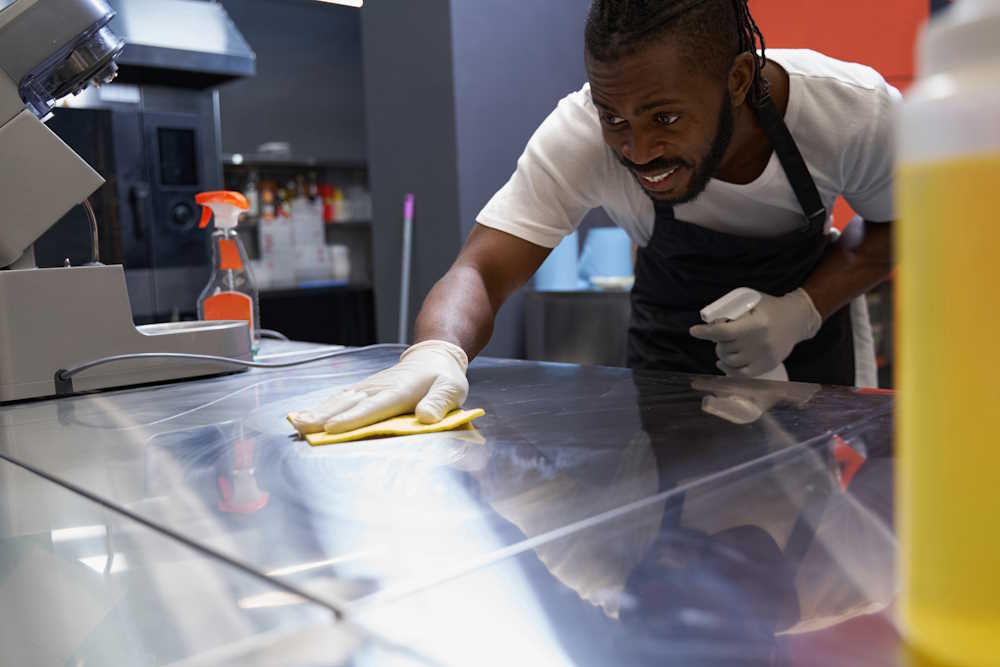Compliance in commercial kitchen cleaning is more than just a legal obligation – it’s a critical safeguard for your business, employees, and customers. Maintaining cleanliness and adhering to regulations is essential to prevent serious risks, such as fire hazards, health violations, and costly legal repercussions.
In Australia, regulatory compliance is rooted in strict national standards and local council requirements to ensure safety and hygiene in busy kitchen environments. However, staying compliant can feel daunting without a clear understanding of the rules and how to implement them effectively.
This guide explains the essential commercial kitchen cleaning compliance regulations and offers actionable tips for keeping your kitchen safe, efficient, and legally compliant.
Commercial Kitchen Cleaning Compliance: What You Need to Know
Commercial kitchens in Australia must adhere to stringent cleaning and safety regulations to maintain public safety and hygiene. These guidelines form the backbone of commercial kitchen cleaning compliance, ensuring establishments operate within legal and safety frameworks. Key Australian standards include:
- AS 1668.1 and AS 1668.2: These standards govern ventilation and air quality in commercial kitchens. They provide clear directives on designing and maintaining systems to efficiently remove heat, smoke, and airborne grease, creating a safer and more comfortable workspace.
- AS 1831: This standard focuses on the design, installation, and maintenance of kitchen exhaust systems. Its goals are to enhance efficiency, reduce fire risks, and ensure compliance with environmental standards.
By following these Australian kitchen cleaning regulations, businesses can ensure their operations meet the highest safety and hygiene benchmarks and avoid the costly consequences of non-compliance.
The Role of Local Councils and Regulatory Bodies
Compliance is not solely about adhering to national standards – it also involves satisfying the requirements of local councils and regulatory authorities. These organisations are critical in monitoring compliance, performing inspections, issuing licenses, and imposing penalties for violations.
Key areas of focus include:
- Fire Safety: Regulatory bodies prioritise fire prevention by ensuring grease does not accumulate in exhaust systems, as grease buildup can fuel dangerous fires. In Australia, kitchens are reported to be the leading source of building fires, accounting for 25% of all structural fires and up to 50% of fires in commercial buildings. Regular inspections and cleaning schedules are crucial to reducing this risk.
- Hygiene Standards: Local councils evaluate whether kitchen surfaces, equipment, and ventilation systems are free from contaminants that can jeopardise food safety. Maintaining cleanliness and hygiene in commercial kitchens is essential to pass these inspections.
- System Design and Maintenance: Authorities assess whether kitchen exhaust systems are designed according to Australian standards and are maintained regularly to ensure optimal performance and energy efficiency.
Meeting these regulations ensures compliance and minimises risks to customers, staff, and the overall business reputation.
8 Key Tips for Maintaining Compliance
1. Perform Regular Inspections and Maintenance
Routine inspections help maintain a grease-free commercial kitchen by identifying grease buildup and other hazards before they become serious issues. Use grease thickness measurements to determine cleaning frequency:
- Low grease production: Inspect quarterly.
- Medium grease production: Inspect monthly.
- High grease production: Inspect weekly.
Checklist for inspections:
- Check grease filters, hood plenums, and ducts.
- Inspect and clean exhaust fans and energy control equipment.
- Assess fire suppression and detection systems for functionality.
2. Create a Structured Cleaning Schedule
Understanding a commercial kitchen cleaning program is essential for maintaining compliance and ensuring the efficiency and safety of your operations. One critical step is to develop cleaning schedules tailored to your kitchen’s activity level and grease production.
- Daily tasks: Surface cleaning, emptying grease traps.
- Weekly tasks: Filter replacements and hood cleaning.
- Monthly tasks: Inspect ductwork.
- Semi-annual/annual tasks: Deep cleaning of ductwork and fans.
Adapt cleaning protocols during peak periods like the holiday seasons.
3. Provide Staff Training and Awareness
Educate staff on compliance standards and daily responsibilities. Focus on:
- “Clean-as-you-go” practices.
- Proper grease and waste disposal.
- Conducting periodic training to keep staff updated on regulatory changes.
Your Guide to a Safe and Compliant Commercial Kitchen
Maintaining compliance in commercial kitchen cleaning requires adhering to strict standards, conducting regular inspections, training staff, and embracing technology. Implementing these practices can create a safer, more efficient kitchen while avoiding costly risks and penalties.
Need help ensuring your kitchen meets regulatory standards? Contact Lotus Commercial for personalised guidance and expert support to keep your operations safe, compliant, and running smoothly.

